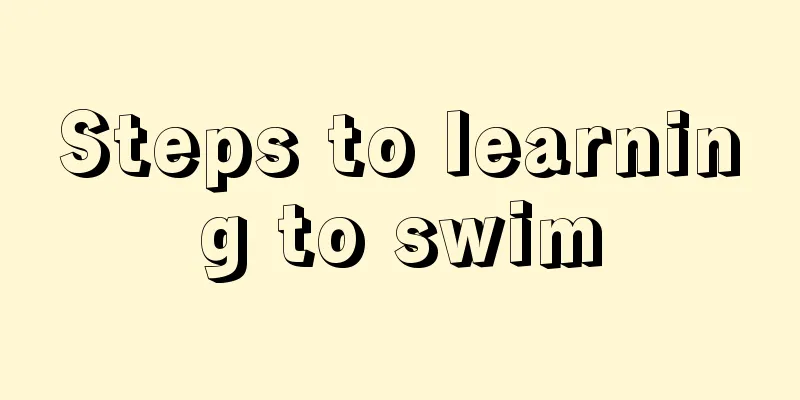Steps to learning to swim

|
Now that living standards have improved, the incidence of obesity, hyperlipidemia, cardiovascular and cerebrovascular diseases remains high. The high incidence of these diseases is largely related to people's lack of exercise. When it comes to fitness, aerobic exercises like swimming are the most effective. Many people can't swim, but they can learn. So what are the steps to learn swimming? There are several steps to learn how to swim: 1. The first thing is to learn how to float in the water. The method is to fix a pillar in the water first, then hold the pillar with your hands, and slowly put your head into the water. Hold your breath, and then slowly lift your head up, breathe, and gradually lift your legs. This is the floating process. 2. To learn the eight-meter drift, the previous drifts required holding on to a pillar, but the eight-meter drift requires no support, no support at all. First squat in the water and hold your breath, then slowly put your head in the water with your legs and arms straight. Just drift slowly for eight meters. 3. Learn to kick your legs. The steps of kicking your legs are: first retract your legs and kick your feet. Also hold your breath well and put your head in the water, then follow the previous steps with your feet. Keep your hands straight. 4. Learn how to row your arms. The steps of rowing your arms are as follows: To prepare, hold your ears with both hands, with your palms facing outward at a 45-degree angle. While rowing, lift your forearms as high as possible, clamp your forearms in front of your chest, and finally return to the preparatory position. Just hold your breath, put your head in the water, and do the previous movements with your hands. Note that when moving your hands, your legs do not move. Arm movements: Outward stroke. Stretch your arms forward with your palms tilted about 45 degrees (pinky fingers facing up). Simultaneously, move both hands outward and backward, then bend your arms and move them backward and downward. Inner line. The palm turns from outside to inside, and the hand drives the forearm to accelerate the inward stroke. The hand moves from bottom to top and is brought together in front of the chest (hand high and elbow low, elbow below the shoulder), and then extends forward. Stretch forward. Extend your arms forward (elbows straight). 5. Learn to breathe. When breathing, do the rowing movement first. When your palms are facing outward at a 45-degree angle, lift your head up to breathe. Exhale first, then inhale back quickly to complete the breathing. Breathe while still doing the arm rowing motion. Count to 3 after completing one move before moving on to the next move. Hold your breath first and put your head in the water. The ventilation is completed. Keep your feet still while you breathe. Leg movements: Leg pull-in: Bend your knees and pull your legs in, bringing your heels closer to your buttocks. Your calves should be tucked behind your thighs and you should pull your legs in slowly to reduce resistance. At the end of the leg retraction, the knees are shoulder-width apart, the calves are perpendicular to the water surface, and the feet are near the water surface. Turn over your feet: The distance between the two feet is greater than the distance between the two knees. The feet are turned outward, toes are facing outward, heels are facing the sky, and the calves and inner sides of the feet are facing the water, like the English letter "W". Kicking the water: It is actually the process of straightening the legs (flexing the hip and extending the knees), with the waist, abdomen and thighs exerting force at the same time, using the calves and inner sides of the feet to kick and clamp the water at the same time, first outwards, backwards, and downwards, and then inwards and upwards, like drawing a half circle. Pushing the water outwards and squeezing the water inwards are completed continuously, that is, pushing and squeezing together. When the kick and catch are completed, the legs are straightened and brought together, the feet are turned inward, and the toes are facing each other. Don't kick the water too fast. Instead, accelerate from slow to fast. The speed of kicking water is the fastest when your legs are almost straight and close together. The above are the steps to learn swimming. Swimming beginners need to pay attention that in order to ensure the safety of learning swimming, they need to wear a swimming ring. During the learning process, they must master the learning essentials and have sufficient patience to learn. At the same time, before learning to swim, you should do some warm-up exercises to prevent leg and foot cramps due to improper exertion or insufficient preparation. |
<<: Things to note when practicing yoga
Recommend
How long after giving birth is it best to practice yoga?
After giving birth, women’s bodies will change to...
Is sweating good during winter sports?
It is normal to sweat a lot during exercise, and ...
What are the weight loss yoga movements?
There are various yoga methods for weight loss, b...
What are the benefits of bowling?
Nowadays, people pay more and more attention to s...
What is the most effective fitness exercise?
Nowadays, people are paying more and more attenti...
How to use aerobic exercise balls
Aerobic exercise balls are actually a tool that h...
What kind of sport is yoga?
Because yoga can beautify and nourish the skin, l...
How to exercise to keep fit
I believe that many friends hope that they can ha...
How to quickly train abdominal muscles?
How can we train our abdominal muscles better, mo...
What are the precautions for elderly people to take when traveling?
It is a common phenomenon that the elderly’s phys...
What are the steps of morning yoga for weight loss
If you want to lose weight successfully and effec...
"Too much is as bad as too little" is so terrible
The latest monitoring results from the Catastroph...
Can hula hooping help you lose weight?
I believe many people are very familiar with the ...
What exercise can slim down your calves?
When others call you thick legs or carrot legs, d...
What are the top ten fitness misunderstandings?
Exercise and fitness can help us exercise our bod...









